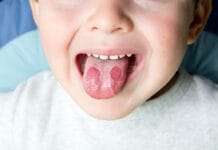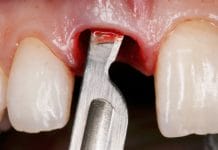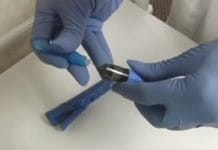Research into the relationship between periodontitis and type 2 diabetes mellitus (T2DM) has identified a bidirectional association. Some studies have found chlorhexidine-containing mouthwash was a successful preventative measure in reducing the risk of developing periodontitis by impeding periodontal pathogens. Yet, the impact of mouthwash on both oral and systemic health parameters in individuals with T2DM remains unexplored.1
In a recent study, the authors investigated the effects of gargling with chlorhexidine-containing mouthwash on the number of red complex species, including Porphyromonas gingivalis, Treponema denticola, and Tannerella forsythia, and HbA1c levels in patients with T2DM.1
The Study
For twelve months, a cohort of one hundred seventy-three patients participated in a structured gargling regimen. The first phase involved gargling with water three times daily for six months, followed by an identical frequency of gargling with chlorhexidine-containing mouthwash for the subsequent six months.1
The gargling protocol entailed using 25 mL of water for 30 seconds per session during the initial phase, while during the subsequent phase, participants utilized ConCool F® mouthwash (Weltec Corp., Osaka, Japan) containing 0.05% chlorhexidine gluconate. Patients were instructed to dilute the mouthwash to approximately 0.00056% (10 drops in 25 mL tap water for each gargle) before each use.1
Throughout the study period, saliva and blood samples were systematically collected during clinic visits, occurring every one to two months, amounting to a total of 6–12 collections per participant. Saliva samples underwent DNA extraction to identify specific bacterial species, notably the three red complex species. Meanwhile, blood samples were analyzed for HbA1c levels.1
The Results
Non-surgical periodontal therapy has shown efficacy in reducing the abundance of red complex species and enhancing glycemic control in individuals with T2DM. Previous studies have also highlighted the positive influence of professional care with oral hygiene instructions on glycemic regulation in T2DM patients. However, little attention has been given to the effects of self-care alone, such as gargling, on the abundance of red complex species and HbA1c levels in this population.1
The findings revealed that while gargling with water did not significantly decrease the number of red complex species, gargling with diluted chlorhexidine-containing mouthwash led to a significant reduction.1
An initial analysis was also completed to examine variations in the abundance of red complex species and HbA1c levels relative to age during gargling sessions with both water and mouthwash. The analysis showed a significant reduction in both the number of red complex species and HbA1c levels among younger patients (aged ≤ 68 years) compared to their older counterparts (aged ≥ 69 years) following chlorhexidine-containing mouthwash gargling.1
Previous studies have indicated that older individuals tend to accumulate more biofilm than their younger counterparts, potentially contributing to challenges in glycemic control among older patients with T2DM due to heightened systemic inflammation associated with aging. These findings suggest that the benefits of improving oral health through chlorhexidine-containing mouthwash gargling may be more pronounced among younger individuals with T2DM.1
When considering sex differences, the analysis revealed a notable reduction in the number of red complex species among male participants only during chlorhexidine-containing mouthwash gargling sessions. Interestingly, variations in HbA1c levels between males and females remained insignificant regardless of the gargling agent used.1
Previous research has highlighted a higher prevalence of P. gingivalis in the subgingival periodontal pockets of females compared to males. This suggests that the differential volume and/or distribution of periodontopathic bacteria could potentially diminish the efficacy of chlorhexidine-containing mouthwash gargling in inhibiting red complex species among female patients.1
Conclusion
The study concluded some “T2DM patients can decrease red complex species by gargling with mouthwash two or three times a day, leading to possible improvement in glycemic control, especially in younger patients.”1
However, during mouthwash gargling, individual patients displayed diverse trends in the alteration of red complex species and glycemic control. Notably, one patient exhibited a substantial decrease in red complex species as well as a decrease in HbA1c levels, while another patient demonstrated no discernible changes in either parameter. These disparities may stem from individual variabilities in factors such as comorbid systemic illnesses, medication regimens, and overall dental or periodontal health status.1
It should be noted that mouthwash with 0.12% chlorhexidine gluconate is recommended for short-term use (two to four weeks).2 In contrast, the chlorhexidine-containing mouthwash used in this study was diluted using a lower concentration of chlorhexidine gluconate (0.00056%) intended for daily use.1
Further studies that comprehensively consider various patient-specific factors to identify the impact of chlorhexidine-containing mouthwash gargling on red complex species abundance and HbA1c levels in individuals with T2DM are warranted.1 Until further studies take place, recommending a diluted chlorhexidine-containing mouthwash for long-term use for patients with T2DM is not suggested.
Before you leave, check out the Today’s RDH self-study CE courses. All courses are peer-reviewed and non-sponsored to focus solely on pure education. Click here now.
Listen to the Today’s RDH Dental Hygiene Podcast Below:
References
- Matayoshi, S., Tojo, F., Suehiro, Y., et al. Effects of Mouthwash on Periodontal Pathogens and Glycemic Control in Patients With Type 2 Diabetes Mellitus. Sci Rep. 2024; 14(1): 2777. https://www.nature.com/articles/s41598-024-53213-x
- Brookes, Z.L.S., Bescos, R., Belfield, L.A., et al. Current Uses of Chlorhexidine for Management of Oral Disease: A Narrative Review. J Dent. 2020; 103: 103497. https://www.ncbi.nlm.nih.gov/pmc/articles/PMC7567658/











